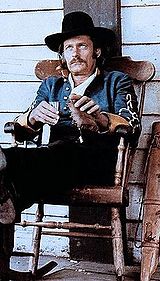They call him Cemetery Review (Scherpschutter)

|
Cast:
Director:
Music:
Screenplay:
Cinematography:
|
They Call him Cemetery (Gli fumavano le Colt... Lo chiamavano Camposanto)
View Database Page | Available DVDs

|
This movie is based on a script by Enzo Barboni, who was also asked to direct it, but after the success of the first Trinity movie, he rejected the offer because he thought the script was too serious. He reckoned audiences wouldn’t accept any other thing from him than a parody. Carnimeo seemed a logical choice to replace Barboni: he had worked extensively with Garko and had shown that he could handle a mix of serious action and tongue-in-cheek humour to perfection. But the Carnimeo from Cemetery, was a different person from the one who had done three Sartana movies with Garko. He had always preferred a more spoofy approach to the Sartana movies, and on the set of Sartana's Coming, Get Your Coffins Ready he had discovered that George Hilton fitted his plans better than Garko. In the meantime Carnimeo and Hilton had made the hilarious They Call me Hallelujah, a western parody with exploding buttons, a nun on the run and sewing machine gun, and the new movie seemed a step into a direction Carnimeo didn’t want to take.
The story is about two brothers, John and George McIntire, who were born in the West, but sent to Boston by their wealthy family to complete their studies. Back home on the ranch, the two find out that their father and his fellow ranchers are squeezed by local protection racketeers. With the help of two Mexican aides, working for old man McIntire, the two manage to scare off one of the money collectors, but now the entire gang is looking for them. Being rather naïve and ill-equipped to make a bold stand against the enemy, they need the help of a mysterious gunman, who takes them into custody, and teaches them how to use a gun and defend themselves. An early scene may give you an impression of what Barboni had in mind. With their crippled father, the two brothers visit the grave of their mother. They’re observed from a high spot by a stranger, who waits until they have departed to descend the slope and visit another grave, in which his wife and children are buried. In the original plans, the boys and the aging gunfighter would meet on the cemetery (1), and the idea was that this gunfighter, who had lost everything, would identify himself with the innocent youngsters, and safeguard them, so they wouldn’t ever become as lost and lonely as he had become.

|
Some of the melancholic aspects of the original premise are still present in the finished movie, for instance in Garko’s conversations with Berger, his colleague gunman, hired by the other side to kill the two brothers. Like Garko, Berger is a loner, the western equivalent of the wandering samurai, with only his professional code of honour to be proud of. Berger realizes that the brothers are still boys, so he’ll have to wait until they’ve grown up to challenge them for a duel, because there’s no honor in killing under aged opponents. Seasoned with some of the tongue-in-cheek humor, this story about inexperienced young men and aging gunfighters, could have become a classic, but instead of some ironic touches, we get often terribly unfunny jokes about sharpshooting grannies and babies sucking on bullets. Instead of one Mexican sidekick we get two, and they get far too much screentime.
There’s nothing wrong with a mix of humor and action, but it’s not only a matter of balance, also of harmony. I think the balance between the funny and more serious moments is quite alright, but the different elements simply don’t harmonize. Either the jokes are too silly and flat, or the background is too serious and elegiac. With Garko and Berger impersonating aging gunslingers, the story adds a tinge of spleen to the iconic spaghetti western character, turning him into a person of flesh and blood. In an extra of the Koch Media Hallelujah Box, Garko explains that it was easy for him and Berger to identify with these aging gunslingers, because they had portrayed gunmen for years, and were in the declining years of their career as western actors, if only because the western production was in decline (2).
Cemetery isn’t bad, it may even be called above average, but it's not the movie it could have been. It must be said that others have judged it more favorably than I do. Tom Betts calls it one of the best Garko-Carnimeo collaborations, and Garko himself has told in several interviews that he was happy with the movie and Carnimeo's direction. To me it’s a frustrating movie because it could easily have been so much better. It’s also a bit sluggish in the fist half, because too much attention is given to bad jokes, the two brothers and their Mexican side-kicks. The pace picks up in the second half, with a series of complications and revelations and a growing rivalry between Garko and Berger, culminating (or not culminating?) in a final duel. It’s really the movie of these two actors, all others, including the boys and the villains remain anonymous, with the exception of Nello Pazzafini, who has a great cameo as a colorful gunslinger bandido style called Cobra Ramirez. Bruno Nicolai’s score is a wonderful mix of upbeat and elegiac tunes, but seems more suited to the movie Barboni had in mind than to the movie Carnimeo made. Stelvio Massi’s camerawork is, as always, tiptop.
Notes:
- (1) Marco Giusti, Dizionario del western all'italiano
- (2) See also: Kevin Grant, Any Gun Can Play, p. 277
--By Scherpschutter



